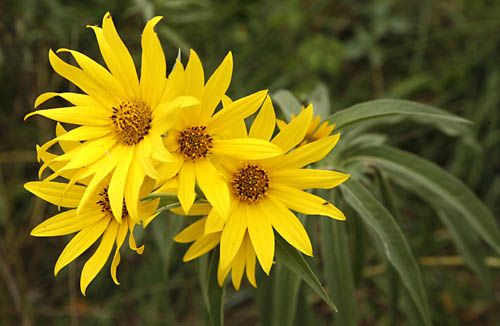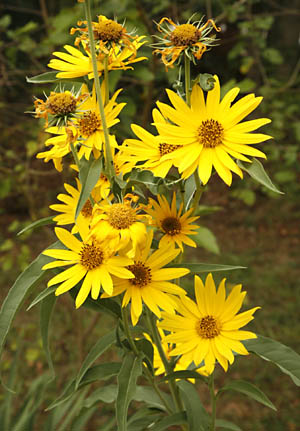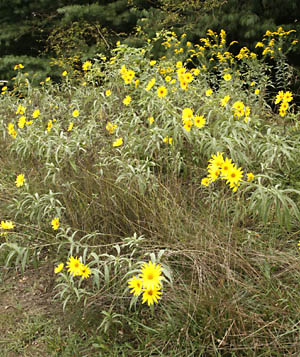This tall native American perennial is ideal for sunny areas that have little other use. Hardy to zone 4 needs full sun but its not fussy about soil type although it does need to be well drained. Fairly drought tolerant and needs very little maintenance once established. Cut down stalks in early winter or spring is all that is needed. Will form dense colonies of tall stems that produce lovely bright yellow daisy flowers in late autumn when most other plants have stopped flowering. It gives color when little else is flowering and much needed energy for pollinators preparing for winter. Wildlife don't eat it but butterflies love the flowers and Finches and other birds adore the seeds. In some areas roots may be eaten by voles.
Description of Perennial Sunflowers (Helianthus maximiliani).
Flowers are very popular with wildlife, butterflies love the flowers and birds adore the seeds.
If starting indoors use small individual pots are seeds are slightly larger and will grow quickly. See our General Growing Instructions for detailed info on seed growing.
Stems will also flop if planted in a shady location. The best places are in full sun where they are mostly exposed to winds rather than a sheltered location as this will encourage strong tall stems. It can then be used as a summer screen or hedge and provide shelter from prevailing winds.
Strong stems also produce tighter more compact colonies of these sunflowers. The plants will drop some seeds and on erect stems these will fall close to the plant creating a slowing increasing tight colony. IF the stems have flopped over the seeds will be dropped further from the original plants forming a more loose and widely space colony. These still look impressive but it may allow for weeds to grow between the plants meaning some maintenance may be required. Tight colonies don't need anything but cutting down in the winter or early spring.
Perennial sunflowers will spread slowly from the rhizomes or seeds that fall. Be sure that you have sufficient room for this plant and can allow for it to spread before you plant it. To keep the plant under control dig up rhizomes on the edges of the colony. The good thing about this is since they are edible you don't have to waste them! They are very similar to Jerusalem artichoke and were used extensively by native Americans.
Rhizomes can be replanted in another area to propagate the plant but this needs to be done very soon after they have been dug up. They don't like to be out of the ground for long.
Finches love the seeds, and will often festoon the plants in late autumn early winter to feast on them. If you want to collect your own seeds you may need to bag the heads to prevent the birds getting there before you.
Dividing the plant and growing from rhizomes is a good method of propagation. However plants need to be replanted very soon after digging and well watered in since they don't like being moved. Water frequently after transplanting until plant recovers.








